Related Research Articles
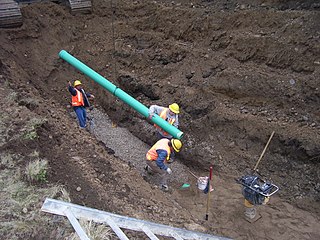
A sanitary sewer or foul sewer is an underground pipe or tunnel system for transporting sewage from houses and commercial buildings to treatment facilities or disposal. Sanitary sewers are part of an overall system called a sewage system or sewerage.

A storm drain, storm sewer, surface water drain/sewer, or stormwater drain is infrastructure designed to drain excess rain and ground water from impervious surfaces such as paved streets, car parks, parking lots, footpaths, sidewalks, and roofs. Storm drains vary in design from small residential dry wells to large municipal systems.
The Boston Water and Sewer Commission (BWSC) serves retail customers with water services in Boston, Massachusetts. It purchases water wholesale from the Massachusetts Water Resources Authority (MWRA).
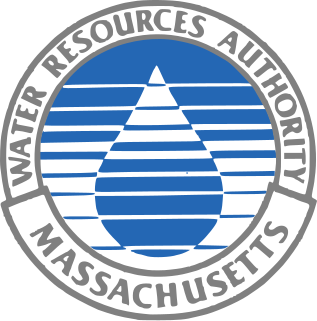
The Massachusetts Water Resources Authority (MWRA) is a public authority in the Commonwealth of Massachusetts that provides wholesale drinking water and sewage services to certain municipalities and industrial users in the state, primarily in the Boston area.

Boston Harbor is a natural harbor and estuary of Massachusetts Bay, and is located adjacent to the city of Boston, Massachusetts. It is home to the Port of Boston, a major shipping facility in the northeastern United States.

The Thames Tideway Tunnel will be a 25 km (16 mi) tunnel running mostly under the tidal section of the River Thames through central London to capture, store and convey almost all the raw sewage and rainwater that currently overflows into the river. Bazalgette Tunnel Limited (BTL) is the licensed 'Infrastructure Provider' set up to finance, build, maintain and operate the Thames Tideway Tunnel. BTL is a consortium of investors that comprises Allianz, Amber Infrastructure, Dalmore Capital and DIF. From the licence award, BTL trades and is known to the public as 'Tideway'. On 3 November 2015, BTL received its operating licence from Ofwat, ensuring the start of the project.

The Milwaukee Metropolitan Sewerage District (MMSD) is a state-chartered government agency which provides wastewater services for 28 municipalities within Milwaukee County and also portions of the surrounding counties. It treats, and also releases, the largest amount of water pollution of any agency or company in the State of Wisconsin.

A combined sewer is a sewage collection system of pipes and tunnels designed to simultaneously collect surface runoff and sewage water in a shared system. This type of gravity sewer design is no longer used in almost every instance worldwide when constructing new sewer systems. Modern-day sewer designs exclude surface runoff from sanitary sewers, but many older cities and towns continue to operate previously constructed combined sewer systems.

Moon Island is situated in Quincy Bay, in the middle of Boston Harbor, Massachusetts, and is the location of the Boston Fire Department Training Academy, and Boston Police Department shooting range. All of the land on the island is owned by the City of Boston but the island is under the jurisdiction of Quincy, Massachusetts. It is also part of the Boston Harbor Islands National Recreation Area.
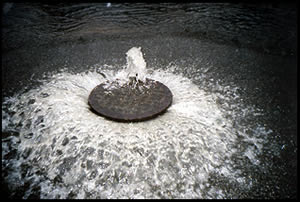
Sanitary sewer overflow (SSO) is a condition in which untreated sewage is discharged from a sanitary sewer into the environment prior to reaching sewage treatment facilities. When caused by rainfall it is also known as wet weather overflow. It is primarily meaningful in developed countries, which have extensive treatment facilities. Frequent causes of SSO spills include:

The Deer Island Waste Water Treatment Plant is located on Deer Island, one of the Boston Harbor Islands in Boston Harbor. The plant is operated by the Massachusetts Water Resources Authority (MWRA) and began partial operations in 1995. The facility was fully operational in 2000 with the completion of the outfall tunnel.

Paerdegat Basin is a channel that connects to Jamaica Bay between the neighborhoods of Bergen Beach and Canarsie in southeast Brooklyn, New York, United States. It connects to Jamaica Bay to the south, and the north end of the basin is adjacent to the intersection of Ralph Avenue and Flatlands Avenue. "Paerdegat" derives from the old Dutch paardengat, meaning "horse gate".
A marine outfall is a pipeline or tunnel that discharges municipal or industrial wastewater, stormwater, combined sewer overflows, cooling water, or brine effluents from water desalination plants to the sea. Usually they discharge under the sea's surface. In the case of municipal wastewater, effluent is often being discharged after having undergone no or only primary treatment, with the intention of using the assimilative capacity of the sea for further treatment. Submarine outfalls are common throughout the world and probably number in the thousands. More than 200 outfalls alone have been listed in a single international database maintained by the Institute for Hydromechanics at Karlsruhe University for the International Association of Hydraulic Engineering and Research (IAHR) / International Water Association (IWA) Committee on Marine Outfall Systems.

South Fairmount is a neighborhood in Cincinnati, Ohio. It contains one of the highest concentrations of Section 8 housing in Hamilton County. The population was 2,368 at the 2010 census. South Fairmount lies just south of the North Fairmount neighborhood.
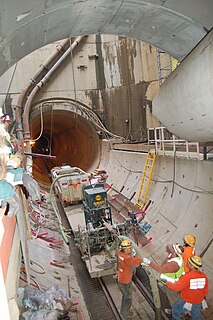
The West Side Combined Sewer Overflow Tunnel is a tunnel in Portland, Oregon, United States. It receives and stores overflow from the combined sewer system before it can reach the Willamette River. The main tunnel is 14 feet (4.3 m) in diameter and 3.5 miles (5.6 km) long for a capacity of 2,850,000 cubic feet (81,000 m3) and connects to dozens of smaller sewer overflow interceptors along the west side of the Willamette River.
The Nut Island effect describes an organizational behavior phenomenon in which a team of skilled employees becomes isolated from distracted top managers resulting in a catastrophic loss of the ability of the team to perform an important mission. The term was coined by Paul F. Levy, a former Massachusetts state official, in an article in the Harvard Business Review published in 2001. The article outlines a situation which resulted in massive pollution of Boston Harbor, and proposes that the name of the facility involved be applied to similar situations in other business enterprises. The work is used as a source in human resources management case studies and is featured on the websites of several business management consulting firms and health care institutions.

Allegheny County Sanitary Authority is a Municipal Authority in Allegheny County, Pennsylvania that provides wastewater treatment services to 83 communities, including the city of Pittsburgh. Its principal sewage treatment plant is along the Ohio River downstream from Pittsburgh.
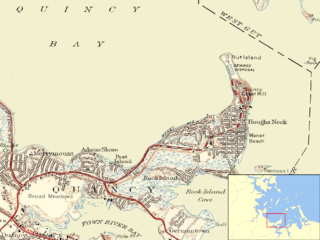
Nut Island is a former island in Boston Harbor, part of the Boston Harbor Islands National Recreation Area. The island has been connected through a short causeway to the end of Houghs Neck, becoming part of the mainland of Quincy, Massachusetts.

The East Side Big Pipe is a large sewer line and tunnel in Portland in the U.S. state of Oregon. It is part of a combined sewer system of pipes, sumps, drains, pumps, and other infrastructure that transports sewage and stormwater run-off to the city's Columbia Boulevard Wastewater Treatment Plant. The East Side Big Pipe project, begun in 2006 and finished in 2011, was the largest of a 20-year series of projects designed to nearly eliminate combined sewer overflows (CSO)s into the Willamette River and the Columbia Slough. The combined projects were completed on time, and they reduced CSOs into the river by 94 percent and into the slough by more than 99 percent.

The Newtown Creek Wastewater Treatment Plant is the largest sewage treatment facility operated by the New York City Department of Environmental Protection. Since 2010, its eight metallic "digester eggs," which are 140 feet tall and dramatically illuminated with blue light at night, have made it a local landmark, particularly to motorists on several nearby roadways in the New York City boroughs of Brooklyn, Queens, and Manhattan. It is located on the Newtown Creek in Brooklyn's Greenpoint neighborhood along Greenpoint Avenue.
References
- ↑ "MWRA - Boston Harbor Project: An Environmental Success Story". Mwra.state.ma.us. 2009-06-03. Retrieved 2011-10-08.
- ↑ "MWRA map of South Boston projects". 2007-06-23. Retrieved 2012-08-18.
- ↑ Massachusetts Water Resources Authority (2007-06-23). "MWRA COMPLETES OVERFLOW TUNNEL IN SOUTH BOSTON" . Retrieved 2012-08-18.